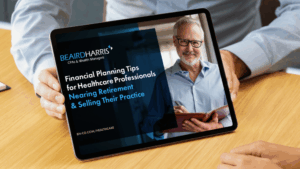
Beaird Harris Named to Worth’s 2025 List of Top RIA Firms for Excellence in Wealth Management
Beaird Harris Recognized in Worth’s list of “Top RIA Firms” for 2025 Beaird Harris is proud to announce our inclusion in Worth’s prestigious list of…


With recession concerns intensifying in the wake of the COVID-19 pandemic, investors may be wondering whether small cap stocks are poised to struggle. Are small companies more vulnerable now than they have been during other periods of economic distress? And what are the implications for the size premium?
Even if the economy has entered a recession, it does not necessarily follow that small cap stocks should underperform. Why? Current market prices already reflect expectations about future cash flows, including any impact of an economic downturn. So even if the effects of a recession are more heavily borne by smaller companies, small cap stocks can still deliver higher expected returns.
Turning to the data, the first question we want to answer is whether small cap companies were displaying any unusual trends leading into the current crisis. If the financial characteristics of small cap firms in recent years have been in line with long-term averages, we can use historical data to help us understand the potential range of outcomes going forward.
One common measure of a company’s relative strength is its leverage, or the relative value of its debt. A company whose financial standing has deteriorated during an economic downturn may experience rising leverage that is less sustainable over a long period. When measured using total debt scaled by total assets (Panel A of Exhibit 1), aggregate leverage rates for US small caps have actually been similar to those for US large caps, and relatively stable through time. Another conventional measure of leverage is interest expense scaled by EBITDA, a way to assess companies’ ability to pay their debt through earnings. As illustrated in Panel B of Exhibit 1, US small caps appear more highly levered than US large caps, but their leverage has remained in line with historical trends.

Another characteristic worth assessing is the proportion of companies with negative earnings. A company with negative earnings going into a recession may face worse odds of persevering through the downturn. Recently, about 25% of the US small cap market reported negative earnings, compared with about 5% of the US large cap market. However, as the historical data in Exhibit 2 illustrate, this is not a particularly new development. The current proportion of US small caps with negative earnings is in line with the norm over the past several decades, both in absolute terms and relative to US large caps.

These data counter the notion that small caps had become particularly vulnerable before the current economic downturn. Therefore, we can use long-run historical data to inform expectations for small cap firms in this environment. For example, historical data on stock delistings suggest that, on average, the stocks of small cap firms tend to be delisted for “bad” reasons (such as liquidations, bankruptcies, or inability to meet exchange listing criteria) more frequently than large cap stocks. From 1927 to 2019, the average annual rate of bad delistings for US small cap stocks was about 2.7%, more than six times the rate for US large caps (0.4%). As Exhibit 3 illustrates, the rate of bad delistings among US small caps has been higher around economic recessions.

The relevant question for investors is whether this pattern will impact the future performance of small cap stocks. It’s important to remember that even if small companies are going “bust” more frequently than larger companies, that doesn’t necessarily imply that returns for all small companies will be lower. Rather, it is sensible to believe that the expected return for small cap stocks as an asset class compensates for the possibility that some individual companies may go out of business.
To assess this, we plot the annual returns for the Fama/French US size factor (which shows how small cap stocks have performed relative to large cap stocks) against the bad delisting rate for US small cap stocks in Exhibit 4. There has been no relation between the rate of delistings for US small caps and the performance of the size premium. Nine of the 16 years in which US small cap delistings exceeded 5% were associated with a positive size premium.

Even during volatile times, markets continue to function, connecting willing buyers and sellers. Market prices quickly incorporate new information and reflect the aggregate expectations of buyers and sellers—including information about the financial health of small cap companies and the impact that coronavirus developments might have on their future performance.
Investors can put themselves in a better position to pursue their financial goals by investing in a broadly diversified portfolio that includes small cap stocks. Diversification can help reduce unnecessary risks associated with the performance of specific companies or industries as well as increase the reliability of outcomes.1
Figure 1 Source: Dimensional, using CRSP and Compustat. Characteristics evaluated for eligible US stocks, excluding financials, each July. Debt is current liabilities plus long-term debt plus other noncurrent liabilities (including deferred taxes, investment tax credit, and minority interest). EBITDA is earnings before interest, taxes, depreciation, and amortization. Large and small cap are defined as approximately the top 92% and bottom 8% of the market capitalization, respectively. Real estate investment trusts (REITs), tracking stocks, and investment companies are excluded from the universe. Past performance, including hypothetical performance, is no guarantee of future results.
Figure 2 Source: Dimensional, using CRSP and Compustat. Earnings are defined as net income before extraordinary items. Characteristics evaluated for eligible US stocks at the end of each July. Large and small cap are defined as approximately the top 92% and bottom 8% of the market capitalization, respectively. REITs, tracking stocks, and investment companies are excluded from the universe. Past performance, including hypothetical performance, is no guarantee of future results.
Figure 3 Source: Dimensional, using CRSP and Compustat. Shaded regions indicate months falling during recessions as designated by the National Bureau of Economic Research (NBER). Small caps are defined as approximately the bottom 8% of the market capitalization, rebalanced annually at the end of each June. The monthly delisting rate of a month between July of Year T and June of Year T+1 is the number of delisting in the month, divided by the number of names in the small cap universe in July of Year T. The one-year rolling delisting rate is computed as the average of the monthly delisting rates over 12 months. Bad delisting events are identified with those with the first digit of the delisting code four, five, or seven, which captures liquidations, delisting by the exchanges, and delisting by the SEC. A firm can be delisted by the exchanges for various reasons including bankruptcies and stock prices falling below the minimum requirement. The detailed description of delisting code is available at: crsp.org/products/documentation/data-definitions-d#delisting-code. Past performance, including hypothetical performance, is no guarantee of future results.
Figure 4 Source: Dimensional, using CRSP and Compustat. Shaded regions indicate months falling during recessions as designated by the National Bureau of Economic Research (NBER). Small caps are defined as approximately the bottom 8% of the market capitalization, rebalanced annually at the end of each June. The monthly delisting rate of a month between July of Year T and June of Year T+1 is the number of delisting in the month, divided by the number of names in the small cap universe in July of Year T. The annual delisting rate is computed as the sum of monthly delisting rates over each calendar year. Bad delisting events are identified with those with the first digit of the delisting code four, five, or seven, which captures liquidations, delisting by the exchanges, and delisting by the SEC. A firm can be delisted by the exchanges for various reasons including bankruptcies and stock prices falling below the minimum requirement. The detailed description of delisting code is available at: crsp.org/products/documentation/data-definitions-d#delisting-code. Size premium data provided by Ken French, available at mba.tuck.dartmouth.edu/pages/faculty/ken.french/data_library.html. Eugene Fama and Ken French are members of the Board of Directors of the general partner of, and provide consulting services to, Dimensional Fund Advisors LP.
FOOTNOTES
1See Dai, Wei. 2016. “How Diversification Impacts the Reliability of Outcomes.” Dimensional Fund Advisors white paper, November 2016.
GLOSSARY
Small Cap: Refers to stocks with a relatively small market capitalization.
Large Cap: Refers to a company with a relatively large market capitalization.
Market Capitalization: The total market value of a company’s outstanding shares, computed as price times shares outstanding.
Size Premium: The return difference between small capitalization stocks and large capitalization stocks.
Leverage: Using borrowed money to increase the potential return of an investment.
Delisting: The removal of a listed security from a stock exchange.
DISCLOSURES
Please remember that past performance may not be indicative of future results. Different types of investments involve varying degrees of risk, and there can be no assurance that the future performance of any specific investment, investment strategy, or product (including the investments and/or investment strategies recommended or undertaken by Beaird Harris Wealth Management, Inc.), or any non-investment related content, made reference to directly or indirectly in this blog will be profitable, equal any corresponding indicated historical performance level(s), be suitable for your portfolio or individual situation, or prove successful. Due to various factors, including changing market conditions and/or applicable laws, the content may no longer be reflective of current opinions or positions. Moreover, you should not assume that any discussion or information contained in this blog serves as the receipt of, or as a substitute for, personalized investment advice from Beaird Harris Wealth Management, Inc. To the extent that a reader has any questions regarding the applicability of any specific issue discussed above to his/her individual situation, he/she is encouraged to consult with the professional advisor of his/her choosing. Beaird Harris Wealth Management, Inc. is neither a law firm nor a certified public accounting firm and no portion of the blog content should be construed as legal or accounting advice. A copy of the Beaird Harris Wealth Management, Inc.’s current written disclosure statement discussing our advisory services and fees is available for review upon request.
—
Adapted from Dimensional’s Can Small Cap Stocks Weather the Storm? The information in this document is provided in good faith without any warranty and is intended for the recipient’s background information only. It does not constitute investment advice, recommendation, or an offer of any services or products for sale and is not intended to provide a sufficient basis on which to make an investment decision. It is the responsibility of any persons wishing to make a purchase to inform themselves of and observe all applicable laws and regulations. Unauthorized copying, reproducing, duplicating, or transmitting of this document are strictly prohibited. Dimensional accepts no responsibility for loss arising from the use of the information contained herein.
“Dimensional” refers to the Dimensional separate but affiliated entities generally, rather than to one particular entity. These entities are Dimensional Fund Advisors LP, Dimensional Fund Advisors Ltd., Dimensional Ireland Limited, DFA Australia Limited, Dimensional Fund Advisors Canada ULC, Dimensional Fund Advisors Pte. Ltd, Dimensional Japan Ltd., and Dimensional Hong Kong Limited. Dimensional Hong Kong Limited is licensed by the Securities and Futures Commission to conduct Type 1 (dealing in securities) regulated activities only and does not provide asset management services.
UNITED STATES: Dimensional Fund Advisors LP is an investment advisor registered with the Securities and Exchange Commission.

Beaird Harris Recognized in Worth’s list of “Top RIA Firms” for 2025 Beaird Harris is proud to announce our inclusion in Worth’s prestigious list of…

At Beaird Harris, we understand that selling a medical or dental practice isn’t just a financial decision—it’s a deeply personal one. After years of serving…

Now that another tax season is in the rearview mirror, what lessons can you take from this year’s filing experience to strengthen your financial future?
Schedule a complimentary call today. We’ll help you get started and learn more about Beaird Harris.